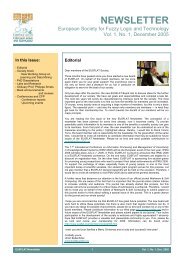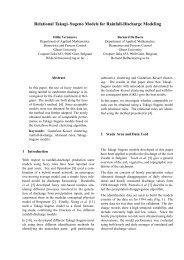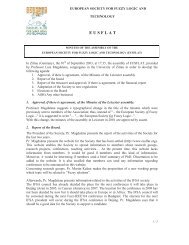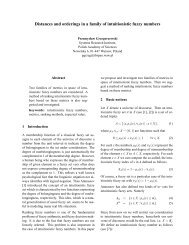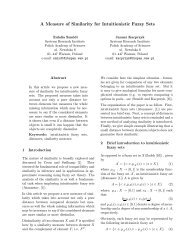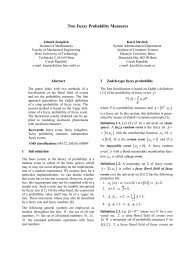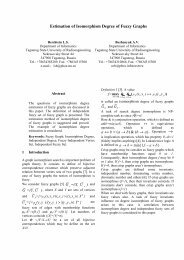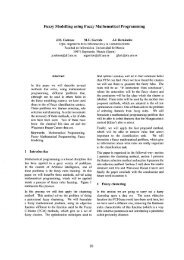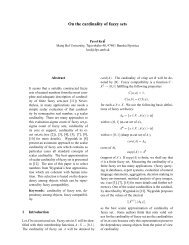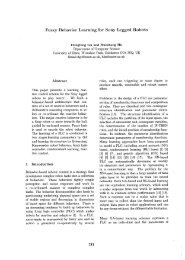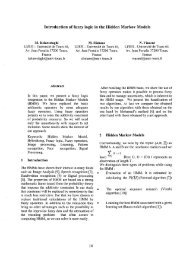Intuitionistic Fuzzy Sets Past, Present and Future - CiteSeerX
Intuitionistic Fuzzy Sets Past, Present and Future - CiteSeerX
Intuitionistic Fuzzy Sets Past, Present and Future - CiteSeerX
Create successful ePaper yourself
Turn your PDF publications into a flip-book with our unique Google optimized e-Paper software.
<strong>Intuitionistic</strong> <strong>Fuzzy</strong> <strong>Sets</strong> <strong>Past</strong>, <strong>Present</strong> <strong>and</strong> <strong>Future</strong><br />
Krassimir T. Atanassov<br />
CLBME - Bulgarian Academy of Sciences, P.O.Box 12, Sofia-1113, Bulgaria<br />
e-mails: krat@bas.bg, krat@clbme.bas.bg<br />
Abstract<br />
Remarks on history, theory, <strong>and</strong> applications<br />
of intuitionistic fuzzy sets are<br />
given. Some open problems are introduced.<br />
Keywords: intuitionistic fuzzy sets.<br />
1 Introduction, or The first steps of<br />
intuitionistic fuzziness<br />
This paper discusses the origin, motivation, current<br />
state of research <strong>and</strong> open problems of an<br />
extension of Zadeh’s fuzzy sets [22].<br />
The author would like to ask the reader to let<br />
him use, whenever personal attitude or opinion is<br />
involved, the first person singular, reserving the<br />
usual ’we’ for statements whose truth is not subjective.<br />
The beginning of the idea of intuitionistic fuzziness<br />
was a happenstance: I was in a hospital<br />
<strong>and</strong> there read the Russian translation of Kaufmann’s<br />
book [14] 1 . It all began as a game: I<br />
added to the definition a second degree (degree of<br />
non-membership) <strong>and</strong> studied the properties of a<br />
set with both degrees. Of course, I saw that the<br />
new set is an extension of the ordinary fuzzy set,<br />
but I did not see immediately that it has essentially<br />
different properties. So the first research<br />
works on IFS followed step by step the existing<br />
results on fuzzy sets. Of course, it is not very<br />
1 In early 80’s, only Russian translations of the books<br />
[22, 14, 12] were available in Bulgaria <strong>and</strong> for this reason<br />
just these books influenced the development of the first<br />
steps of IFS theory.<br />
difficult to extend formally some concepts. It is<br />
interesting to show that the respective extension<br />
has specific properties, not available in the basic<br />
concept. Just when I convinced myself that the<br />
so-constructed sets really had worthy properties,<br />
I discussed them with my supervisor at the Mathematical<br />
Faculty of Sofia University - George Gargov<br />
(7 April 1947 - 9 Nov. 1996) - one of the most<br />
colourful Bulgarian mathematicians, <strong>and</strong> a person<br />
with various interests in science - mathematics,<br />
physics, biology, philosophy, linguistics, psychology,<br />
sociology etc., <strong>and</strong> arts - literature, music,<br />
theatre, cinema, art. He proposed the name “<strong>Intuitionistic</strong><br />
<strong>Fuzzy</strong> Set” (IFS), because the way of<br />
fuzzification contains the intuitionistic idea (see,<br />
e.g. [13]).<br />
Of course the question “Are there adequate examples<br />
of the new definition?” immediately arose.<br />
The answer is “yes”. Here is an example (cf. [3]).<br />
Let E be the set of all countries with elective governments.<br />
Assume that we know for every country<br />
x ∈ E the percentage of the electorate that<br />
have voted for the corresponding government.<br />
Denote it by M(x) <strong>and</strong>letµ(x) = M(x)<br />
100 (degree of<br />
membership, validity, etc.). Let ν(x) =1− µ(x).<br />
This number corresponds to the part of electorate<br />
who have not voted for the government. By fuzzy<br />
set theory alone we cannot consider this value in<br />
more detail. However, if we define ν(x) (degree of<br />
non-membership, non-validity, etc.) as the number<br />
of votes given to parties or persons outside<br />
the government, then we can show the part of electorate<br />
who have not voted at all or who have given<br />
bad voting-paper <strong>and</strong> the corresponding number<br />
will be π(x) =1− µ(x) − ν(x) (degree of indeterminacy,<br />
uncertainty, etc.). Thus we can construct
the set {x, µ(x),ν(x)|x ∈ E} <strong>and</strong> obviously,<br />
0
1<br />
0<br />
E<br />
Figure 1<br />
Its analogue is given in Figure 2.<br />
1<br />
0<br />
(0,1)<br />
@@<br />
@<br />
@<br />
@<br />
@<br />
@<br />
À<br />
F •<br />
p(x)<br />
E<br />
Figure 2<br />
(0,0) (1,0)<br />
@<br />
@<br />
Figure 3<br />
@<br />
@<br />
@<br />
E<br />
fA<br />
-<br />
-<br />
•<br />
x<br />
µA<br />
νA<br />
1 − νA<br />
µA<br />
Let a universe E be given. Consider the figure<br />
F in the Euclidean plane with a Cartesian coordinate<br />
system. The IFS-interpretation in Fig. 3<br />
does not have analogues in fuzzy set theory. Now,<br />
all elements of a given fuzzy set will be represented<br />
only by points of the hypotenuse.<br />
Let A ⊂ E be a fixed set. Then we can construct a<br />
function fA from E to F such that if x ∈ E, then<br />
p(x) =fA(x) ∈ F, the point p has coordinates<br />
a, b for which: 0
while for a proper IFS A:<br />
<strong>and</strong><br />
A ⊂ A ⊂♦A<br />
A = A = ♦A.<br />
Also the following equalities are valid for each IFS<br />
A:<br />
A = ♦A,<br />
♦A = A.<br />
In modal logic both operators <strong>and</strong> ♦ are related<br />
to the last two connections, but no other<br />
connection between them is observed. In the<br />
IFS-case, we can see that operators Dα <strong>and</strong> Fα,β<br />
(α, β ∈ [0, 1] <strong>and</strong> α + βn,<br />
the two estimations correspond only to the people<br />
opinion on voting day <strong>and</strong> it will be changed<br />
afterwards. This change can be represented by<br />
some of the extended modal operators. For example,<br />
if the interest in politics falls, we shall use<br />
operator Gα,β. Inalltheseexamples,thechoice<br />
of the parameters α <strong>and</strong> β is important <strong>and</strong> their<br />
values are obtained by experts.<br />
Two analogues of the topological operators can<br />
be defined over the IFSs, too: operator “closure”<br />
C <strong>and</strong> operator “intersection” I:<br />
C(A) ={x, sup µA(y), inf<br />
y∈E y∈E νA(y)|x ∈ E},<br />
I(A) ={x, inf<br />
y∈E µA(y), sup νA(y)|x ∈ E}.<br />
y∈E<br />
It is very interesting to note that the IFSinterpretations<br />
of both operators coincide, respectively,<br />
with the IFS-interpretations of the logic<br />
quantifiers ∃ <strong>and</strong> ∀ (see, e.g. [3]).<br />
Finally, it will be interesting to mention that IFSs<br />
can be represented in the form A, B, whereA<br />
<strong>and</strong> B are ordinary fuzzy sets (see, e.g. [9, 18]).<br />
For this reason it may be wrongly considered that<br />
IFSs are trivial extensions of ordinary fuzzy sets.<br />
We use the following argument against such a<br />
claim. To state this is analogous to asserting that<br />
the set of the complex numbers is a trivial extension<br />
of the set of the real numbers.<br />
All operators discussed above can be transformed<br />
for the IVFS case, too, because they are not defined<br />
there. On the other h<strong>and</strong>, using IFS-form,<br />
we can work easier with interval data, than with<br />
IVFS-form. Also, we can easy interpret interval<br />
data as points of the IFS-interpretation triangle.<br />
For example, let us have the set of intervals<br />
[a1,b1], [a2,b2],..., [an,bn]. Let A< min ai <<br />
max bi
More interesting is the case (see [7]) when interval<br />
data are elements of two (or more) sets. Then we<br />
can obtain, e.g., IFS-geometrical interpretation in<br />
Fig. 4. <strong>and</strong> using topological operators, defined<br />
over IFS, we can separate these sets.<br />
0, 1 @@<br />
@<br />
@<br />
@<br />
o @<br />
x @<br />
@<br />
x x@<br />
x @<br />
x @<br />
@<br />
0, 0 1, 0<br />
x<br />
o<br />
o o o<br />
Fig. 4<br />
The concept of IVFS was extended in the sense<br />
of the IFS to “interval-valued IFS”. For the new<br />
sets it was shown that they have some essentially<br />
new properties than the ordinary IFS.<br />
Similar is the situation with the L-fuzzy sets. Really,<br />
each IFS can be interpreted as a L-fuzzy<br />
set, because the IFS-interpretation triangle can<br />
be interpreted as a complete lattice. On the<br />
other h<strong>and</strong>, many kinds of L-fuzzy sets have IFSinterpretation,<br />
while still many of them cannot<br />
represent a given IFS (see the paper of Chris<br />
Cornelis, Etienne Kerre <strong>and</strong> the author for the<br />
present conference). Following the idea of the<br />
L-fuzzy sets, in 1984 Stefka Stoeva <strong>and</strong> the author<br />
introduced the concept of “<strong>Intuitionistic</strong> L-<br />
<strong>Fuzzy</strong> Set. Late, in [10] Dogan Coker proved<br />
that Pawlak’s fuzzy rough sets are intuitionistic<br />
L-fuzzy sets, while Guo-jun Wang <strong>and</strong> Ying-Yu<br />
He in [21], <strong>and</strong> Chris Cornelis, Etienne Kerre <strong>and</strong><br />
Glad Deschrijver in [11] discussed relations between<br />
L-fuzzy sets <strong>and</strong> IFSs.<br />
In [3] there are IFSs over different universes <strong>and</strong><br />
IFSs of type 2, for which (1) is changed with<br />
µA(x) 2 + νA(x) 2
proved that certain intuitionistic fuzzy entropies<br />
are intuitionistic fuzzy measures. On this theme<br />
there are papers of T. Gerstenkorn, J. Manko, P.<br />
Burillo, H. Bustince, <strong>and</strong> others.<br />
The notion of intuitionistic fuzzy metric space is<br />
presented by O. Ozbakir <strong>and</strong> D. Coker. The solution<br />
concept for a semi linear equation with the<br />
fuzzy parameters is studied by Keti Peeva <strong>and</strong><br />
Said Melliani.<br />
A lot of research is devoted to <strong>Intuitionistic</strong> <strong>Fuzzy</strong><br />
Logic (IFL). There are a lot of papers by G. Gargov,<br />
A. Ban, H. Bustince, E. Kerre, C. Cornelis,<br />
N. Nikolov, <strong>and</strong> the author in which intuitionistic<br />
fuzzy propositional <strong>and</strong> predicate calculus,<br />
intuitionistic fuzzy modal <strong>and</strong> temporal logic are<br />
discussed. Norms <strong>and</strong> metrics over intuitionistic<br />
fuzzy logics <strong>and</strong> relations between the quantifiers<br />
<strong>and</strong> the modal type of operators in intuitionistic<br />
fuzzy logics are studied. Rules of inference <strong>and</strong><br />
the notion of intuitionistic fuzzy deductive closure<br />
are investigated.<br />
<strong>Intuitionistic</strong> fuzzy model of the axioms of the<br />
paraconsistent set theory NF1, intuitionistic logic<br />
<strong>and</strong> others are presented. <strong>Intuitionistic</strong> fuzzy<br />
interpretation of the conditional logic VW <strong>and</strong><br />
Kun’s axiom are given. It is proved that the<br />
Hauber’s law is an intuitionistic fuzzy tautology.<br />
In the last ten years IFS were applied in different<br />
areas. The IF-approach to artificial intelligence<br />
includes treatment of decision making <strong>and</strong> machine<br />
learning, neural networks <strong>and</strong> pattern recognition,<br />
expert systems database, machine reasoning,<br />
logic programming <strong>and</strong> IF Prolog, Petri nets<br />
<strong>and</strong> generalized nets.<br />
In the last ten years IFS were used in the process<br />
of decision making. Eulalia Szmidt <strong>and</strong> Janusz<br />
Kacprzyk, Humberto Bustince <strong>and</strong> Pedro Burillo,<br />
Adrian Ban <strong>and</strong> Cecilia Temponi, Gabriella Pasi,<br />
Ronald Yager <strong>and</strong> the author obtained interesting<br />
results in this direction. E. Szmidt <strong>and</strong><br />
J. Kacprzyk extend the classical Bellman <strong>and</strong><br />
Zadeh’s general approach to decision making under<br />
fuzziness, originally termed decision making<br />
in a fuzzy environment, to the case of IFS.<br />
<strong>Intuitionistic</strong> fuzzy versions of one of the basic<br />
statistical nonparametrical methods <strong>and</strong> the k-<br />
NN method, are proposed by Ludmila Kouncheva,<br />
Stefan Hadjitodorov, Ognian Asparoukhov <strong>and</strong><br />
others.<br />
Currently, IFSs have applications in various areas.<br />
There are applications of IFSs in medical<br />
diagnosis <strong>and</strong> in decision making in medicine,<br />
deevloped by Anthony Shannon, Soon Ki-<br />
Kim, Eulalia Szmidt, Janusz Kacprzyk, Humebrto<br />
Bustince, Joseph Sorsich <strong>and</strong> others.<br />
Plamen Angelov has solved some optimization<br />
problems by means of intuitionistic fuzzy sets <strong>and</strong><br />
alsohasworkedonoptimizationinanintuitionistic<br />
fuzzy environment.<br />
There are many applications of IFS in chemistry.<br />
Some more interesting of them are following: a<br />
method for simulation of complex technological<br />
system by use of IF generalized nets, an IF generalized<br />
net approach for optimal scheduling of<br />
iron ore delivering, discharge <strong>and</strong> blending yards<br />
creation <strong>and</strong> others.<br />
IFSapproachincreditriskassessmentisproposed<br />
in a series of works by Dinko Dimitrov.<br />
Olympia Georgieva has described the key process<br />
variable <strong>and</strong> corrective actions of the waste water<br />
treatment plant with biosorption using the theory<br />
of IFSs. There are also IF generalized nets models<br />
of the gravitational field, in astronomy, sociology,<br />
biology, musicology, controllers, <strong>and</strong> others.<br />
<strong>Intuitionistic</strong> fuzzy systems <strong>and</strong> IF abstract<br />
systems are defined <strong>and</strong> studied by Valentina<br />
Radeva, Hristo Aladjov <strong>and</strong> the author.<br />
A first step to describe a theory of the IFgraphs<br />
<strong>and</strong> temporal IF-graphs is made by Anthony<br />
Shannon <strong>and</strong> the author. Application of<br />
IF-graphs <strong>and</strong> IF-relation methods are also developed.<br />
Of course, the list of the authors <strong>and</strong> their research<br />
is essentially longer <strong>and</strong> it will be an object<br />
of a new research, continuation of [16].<br />
3 About the IFS-future<br />
Like all young theories, the theory of IFSs contains<br />
a lot of open problems. While wellestablished<br />
theories contain famous problems<br />
with solutions that seem a matter of distant future,<br />
a number of “technical” problems persist in
new theories, perhaps not so hard but requiring<br />
plenty of time <strong>and</strong> research effort. IFS theory is<br />
now at its beginning, <strong>and</strong> most of its problems are<br />
of the latter type - nevertheless, there are some<br />
mathematical challenges of great interest to every<br />
researcher.<br />
In [3, 4] the author gave a list of open problems.<br />
Here we shall introduce some of the most important.<br />
All notations used here are described in [22]. A<br />
list of open problems is introduced there, but the<br />
present one is substantially updated <strong>and</strong> completed.<br />
Problem 1: Construct an axiomatic system of<br />
the IFSs.<br />
Problem 2: Develop efficient algorithms for<br />
construction of degree of membership <strong>and</strong> nonmembership<br />
of a given IFS.<br />
Problem 3: The IFS modal operators <strong>and</strong><br />
♦ are analogues of the same operators from ordinary<br />
modal logic. Is it possible to construct in<br />
ordinary modal logic analogues of the extensions<br />
of the IFS modal operators — Dα,Fα,β,Gα,β, etc.<br />
For example, the fact that = D0 <strong>and</strong> ♦ = D1<br />
shows the unity of the two ordinary modal logic<br />
operators.<br />
Problem 4: What other norms, distances <strong>and</strong><br />
metrics (essential from the st<strong>and</strong>point of the IFS<br />
applications) can be defined over IFSs <strong>and</strong> over<br />
their extensions <strong>and</strong> what properties will they<br />
have?<br />
Problem 5: Develop a theory of IF numbers<br />
(<strong>and</strong> IF complex numbers) <strong>and</strong> study their properties.<br />
Problem 6: Develop IF-geometry, IF topology,<br />
IF analysis - in particular, IF differential <strong>and</strong> IF<br />
integral.<br />
Problem 7: Algorithms for solving IF equations<br />
<strong>and</strong> inequalities <strong>and</strong> systems of IF equations<br />
<strong>and</strong> inequalities of algebraic, differential <strong>and</strong> other<br />
types.<br />
Problem 8: What other extensions <strong>and</strong> modifications<br />
of the IFSs can be introduced <strong>and</strong> what<br />
properties will they have?<br />
Problem 9: What are the connections between<br />
the IFSs (<strong>and</strong> their modifications) <strong>and</strong> the other<br />
fuzzy set extensions?<br />
Problem 10: Develop an axiomatic systems for<br />
the IF logics (propositional, modal. temporal,<br />
etc.).<br />
Problem 11: Develop IF Prolog <strong>and</strong> IF constraint<br />
logic programming.<br />
Problem 12: Develop an IF approach to computational<br />
linquistics, including an approach to<br />
natural language semantics based on IF logic.<br />
Problem 13: Develop IF preference theory <strong>and</strong><br />
IF utility theory.<br />
Problem 14: Define <strong>and</strong> study the properties of<br />
IF Boolean algebras.<br />
Problem 15: Investigate the concepts of IFinformation<br />
<strong>and</strong> IF-entropy.<br />
Problem 16: Develop IF interpretations of abductive<br />
<strong>and</strong> approximate reasoning <strong>and</strong> possibilistic<br />
logic.<br />
Problem 17: Develop statistical <strong>and</strong> probabilistical<br />
tools for IFS <strong>and</strong> IFL.<br />
Problem 18: Develop algorithms for defuzzification<br />
<strong>and</strong> comparison of IFSs.<br />
Problem 19: DevelopanIFinterpretationof<br />
quantum logic.<br />
Problem 20: DevelopanIFinterpretationof<br />
many-sorted logic.<br />
Solving any of the above problems (as well as a<br />
lot of other unformulated here problems) will promote<br />
the development of the IFS theory.<br />
For twenty years <strong>and</strong> especially in the last eight<br />
ones, the IFS research increased essentially.<br />
Since 1997, annual conferences on IFS are organized<br />
in Bulgaria <strong>and</strong> since 2001 - another in<br />
Pol<strong>and</strong>.<br />
The journal “Notes on <strong>Intuitionistic</strong> <strong>Fuzzy</strong> <strong>Sets</strong>”<br />
(NIFS, ISSN-1310-4926) is regularly published<br />
since 1995.<br />
In [16] Mariana Nikolova, Nikolai Nikolov, Chris<br />
Cornelis, <strong>and</strong> Glad Deschrijver, prepared after an<br />
invitation of the Editor-in-Chief Prof. T. Kim <strong>and</strong>
published in “Advanced Studies in Contemporary<br />
Mathematics” a survey of the research on intuitionistic<br />
fuzzy sets. Now, two years after this the<br />
number of papers on IFSs increased by at least<br />
a hundred. Following the references of [16] we<br />
can see that there are authors from more than 30<br />
countries in the world who work successfully on<br />
the theory <strong>and</strong> applications of the IFSs.<br />
Having in mind all this, the author is an optimist<br />
for the future of the IFSs.<br />
References<br />
[1] Atanassov K. <strong>Intuitionistic</strong> fuzzy sets, VII<br />
ITKR’s Session, Sofia, June 1983 (Deposed in<br />
Central Sci. - Techn. Library of Bulg. Acad. of<br />
Sci., 1697/84) (in Bulg.).<br />
[2] Atanassov K. Review <strong>and</strong> new results on intuitonistic<br />
fuzzy sets. Preprint IM-MFAIS-1-88, Sofia,<br />
1988.<br />
[3] Atanassov K., <strong>Intuitionistic</strong> <strong>Fuzzy</strong> <strong>Sets</strong>, Springer<br />
Physica-Verlag, Berlin, 1999.<br />
[4] Atanassov K., Open problems in intuitionistic<br />
fuzzy sets theory. Proceedings of 6-th Joint Conf.<br />
on Information Sciences, Research Triangle Park<br />
(North Carolina, USA), March 8-13, 2002, 113-<br />
116.<br />
[5] Atanassov K., On the temporal intuitionistic<br />
fuzzy sets. Proc. of the Ninth International Conf.<br />
IPMU 2002, Vol. III, Annecy, France, July 1-5,<br />
2002, 1833-1837.<br />
[6] Atanassov K., G. Gargov, Interval valued intuitionistic<br />
fuzzy sets, <strong>Fuzzy</strong> <strong>Sets</strong> <strong>and</strong> Systems, Vol.<br />
31, 1989, No. 3, 343-349.<br />
[7] Atanassov K., V. Kreinovich, <strong>Intuitionistic</strong> fuzzy<br />
interpretation of intetrval data, Notes on <strong>Intuitionistic</strong><br />
<strong>Fuzzy</strong> <strong>Sets</strong>, Vol. 5 (1999), No. 1, 1-8.<br />
[8] Atanassov, K., S. Stoeva, <strong>Intuitionistic</strong> fuzzy sets,<br />
Polich Symp. on Interval & <strong>Fuzzy</strong> Mathematics,<br />
Poznan, Aug. 1983, Proc. 23-26.<br />
[9] Buhaescu, T., On the convexity of intuitionistic<br />
fuzzy sets, Itinerant Seminar of functional<br />
equations, approximation <strong>and</strong> convexity, Cluj-<br />
Napoca, 1988, 137-143.<br />
[10] Coker D., <strong>Fuzzy</strong> rough sets are intuitionistic Lfuzzy<br />
sets, <strong>Fuzzy</strong> <strong>Sets</strong> <strong>and</strong> Systems, Vol. 96, 1998,<br />
No. 3, 381-383.<br />
[11] Deschrijver G., E. Kerre, On the relationship between<br />
some extensions of fuzzy set theory. <strong>Fuzzy</strong><br />
<strong>Sets</strong> <strong>and</strong> Systems, Vol. 133 (2003), No. 2, 227-<br />
235.<br />
[12] Dubois, D., H. Prade. <strong>Fuzzy</strong> <strong>Sets</strong> <strong>and</strong> Systems:<br />
Theory <strong>and</strong> Applications. Acad. Press, New York,<br />
1980.<br />
[13] Heyting, A., Intuitionism. An Introduction.<br />
North-Holl<strong>and</strong>, Amsterdam, 1956.<br />
[14] Kaufmann, A., Introduction a la théorie des sousensembles<br />
flous. Masson, Paris, 1977.<br />
[15] Maji P.K., R. Biswas, A.R. Roy, <strong>Intuitionistic</strong><br />
fuzzy soft sets. The Journal of <strong>Fuzzy</strong> Mathematics,<br />
Vol. 9, 2001, No. 3, 677-692.<br />
[16] Nikolova M., N. Nikolov, C. Cornelis, G. Deschrijver,<br />
Survey of the research on intuitionistic fuzzy<br />
sets. Advanced Studies in Contemporary Mathematics,<br />
Vol. 4, 2002, No. 2, 127-157.<br />
[17] Rizvi S., H.J. Naqvi, D. Nadeem. Rough intuitionistic<br />
fuzzy sets. Proceedings of 6-th Joint<br />
Conf. on Information Sciences, Research Triangle<br />
Park (North Carolina, USA), March 8-13, 2002,<br />
101-104.<br />
[18] Rocha L. M., Kreinovich V., Baker Kearfott R.,<br />
Computing uncertainty in interval based sets, in<br />
Applications of Interval Computations (R. Baker<br />
Kearfott <strong>and</strong> V. Kreinovich, Eds.), Kluwer Academic<br />
Publishers, Dordrecht, 1996, 337-380.<br />
[19] Samanta S.K., T.K. Mondal, <strong>Intuitionistic</strong> fuzzy<br />
rough sets <strong>and</strong> rough intuitionistic fuzzy sets. The<br />
Journal of <strong>Fuzzy</strong> Mathematics, Vol. 9, 2001, No.<br />
3, 561-582.<br />
[20] Takeuti G., Titani S. <strong>Intuitionistic</strong> fuzzy logic<br />
<strong>and</strong> intuitionistic fuzzy set theory. The Journal<br />
of Symbolic Logic, Vol. 49, No. 3, Sept. 1984,<br />
851-866.<br />
[21] Wang G., He Y., <strong>Intuitionistic</strong> fuzzy sets <strong>and</strong><br />
L-fuzzy sets, <strong>Fuzzy</strong> <strong>Sets</strong> <strong>and</strong> Systems, Vol. 110<br />
(2000), No. 2, 271-274.<br />
[22] Zadeh, L., The Concept of a Linguistic Variable<br />
<strong>and</strong> its Application to Approximate Reasoning.<br />
American Elsevier Publ. Co., New York, 1973.



